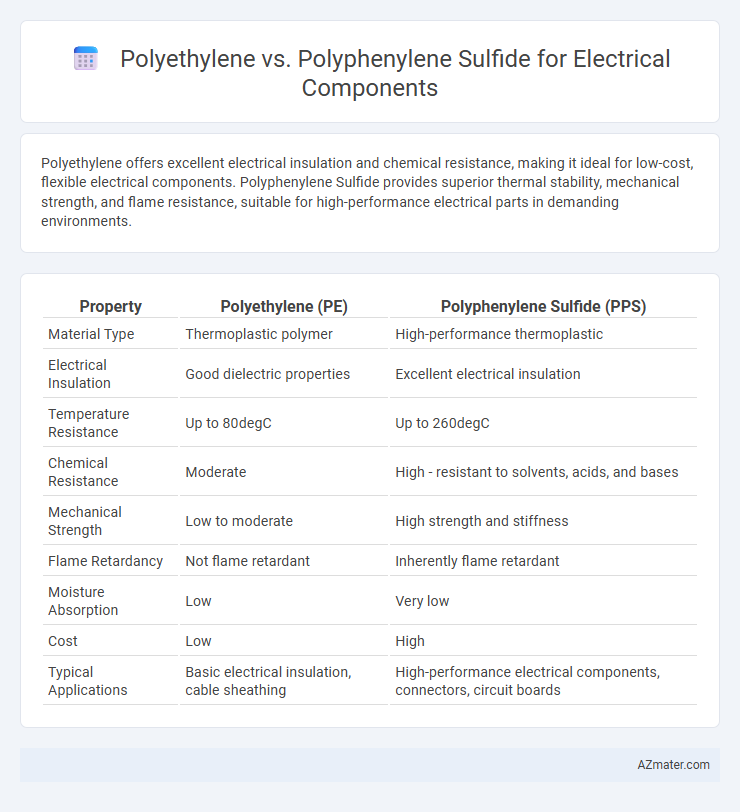Polyethylene offers excellent electrical insulation and chemical resistance, making it ideal for low-cost, flexible electrical components. Polyphenylene Sulfide provides superior thermal stability, mechanical strength, and flame resistance, suitable for high-performance electrical parts in demanding environments.
Table of Comparison
| Property | Polyethylene (PE) | Polyphenylene Sulfide (PPS) |
|---|---|---|
| Material Type | Thermoplastic polymer | High-performance thermoplastic |
| Electrical Insulation | Good dielectric properties | Excellent electrical insulation |
| Temperature Resistance | Up to 80degC | Up to 260degC |
| Chemical Resistance | Moderate | High - resistant to solvents, acids, and bases |
| Mechanical Strength | Low to moderate | High strength and stiffness |
| Flame Retardancy | Not flame retardant | Inherently flame retardant |
| Moisture Absorption | Low | Very low |
| Cost | Low | High |
| Typical Applications | Basic electrical insulation, cable sheathing | High-performance electrical components, connectors, circuit boards |
Introduction to Polyethylene and Polyphenylene Sulfide
Polyethylene (PE) is a widely used thermoplastic known for its excellent electrical insulation properties, high chemical resistance, and flexibility, making it suitable for various electrical components such as wire insulation and cable jackets. Polyphenylene Sulfide (PPS) is a high-performance engineering thermoplastic characterized by superior thermal stability, dimensional stability, and a strong resistance to chemicals and flame, often used in applications requiring enhanced durability and heat resistance in electrical connectors and housings. Comparing PE and PPS highlights differences in temperature tolerance, mechanical strength, and environmental resistance essential for selecting materials in electrical component manufacturing.
Chemical Structure Comparison
Polyethylene (PE) features a simple linear hydrocarbon backbone consisting of repeating ethylene units (-CH2-CH2-), resulting in a non-polar, flexible polymer ideal for insulation due to its excellent dielectric properties and chemical stability. Polyphenylene Sulfide (PPS), by contrast, has a rigid aromatic backbone with alternating phenylene rings and sulfur atoms (-C6H4-S-), providing superior thermal resistance, chemical resistance, and dimensional stability crucial for high-performance electrical components. The aromatic sulfide linkages in PPS confer enhanced electrical insulation and mechanical strength under harsh operating conditions compared to the saturated aliphatic chains of polyethylene.
Mechanical Properties Overview
Polyphenylene sulfide (PPS) exhibits superior mechanical properties compared to polyethylene (PE) for electrical components, including higher tensile strength, enhanced dimensional stability, and greater resistance to deformation under mechanical stress. PPS also maintains mechanical integrity at elevated temperatures, making it ideal for high-performance electrical applications. In contrast, polyethylene offers good flexibility and impact resistance but lacks the thermal and mechanical robustness required for demanding electrical component environments.
Electrical Insulation Capabilities
Polyphenylene Sulfide (PPS) offers superior electrical insulation capabilities compared to Polyethylene (PE) due to its high dielectric strength and thermal stability, maintaining performance in temperatures up to 260degC. PPS exhibits excellent resistance to electrical tracking and arc erosion, making it ideal for high-performance electrical components requiring reliability under harsh conditions. In contrast, polyethylene provides good insulation but is limited by lower temperature tolerance and susceptibility to electrical degradation over time.
Thermal Stability and Heat Resistance
Polyphenylene Sulfide (PPS) exhibits superior thermal stability and heat resistance compared to Polyethylene (PE), maintaining structural integrity at continuous service temperatures up to 200degC, while polyethylene typically withstands only up to 80-90degC. PPS's high melting point around 285degC and excellent dimensional stability under thermal stress make it ideal for electrical components exposed to high temperatures and harsh environments. Polyethylene's lower thermal resistance limits its application in high-temperature electrical insulation and connectors, where PPS offers enhanced performance and longevity.
Chemical and Corrosion Resistance
Polyphenylene Sulfide (PPS) exhibits superior chemical and corrosion resistance compared to Polyethylene (PE), especially in harsh environments involving strong acids, bases, and solvents. PPS maintains its structural integrity at elevated temperatures up to 260degC, resisting oxidation and hydrolysis, while PE typically degrades under prolonged chemical exposure and temperatures above 80degC. The inherent aromatic backbone and sulfur linkages in PPS provide enhanced durability for electrical components subjected to aggressive chemical conditions, making it preferable for long-term reliability.
Processing and Manufacturing Differences
Polyethylene (PE) offers ease of processing through extrusion and injection molding due to its lower melting point and high ductility, making it suitable for cost-effective mass production of electrical components. Polyphenylene Sulfide (PPS), with its high thermal stability and chemical resistance, requires more specialized processing conditions such as high-temperature injection molding and compression molding, often using precision-controlled cooling to maintain dimensional stability. The manufacturing differences influence the choice between PE for flexible, low-cost applications and PPS for high-performance electrical parts exposed to elevated temperatures and harsh environments.
Cost and Economic Considerations
Polyethylene offers a lower initial cost and widespread availability, making it a cost-effective choice for general electrical insulation applications. Polyphenylene Sulfide (PPS), although more expensive, provides superior thermal stability, chemical resistance, and mechanical strength, reducing long-term maintenance and replacement costs in high-performance electrical components. Evaluating total lifecycle expenses highlights PPS as a more economical option for demanding environments despite its higher upfront investment.
Typical Applications in Electrical Components
Polyethylene is widely used in electrical components such as insulation for wiring, cable jacketing, and circuit board substrates due to its excellent dielectric properties and moisture resistance. Polyphenylene sulfide (PPS) is preferred for high-temperature electrical components like connectors, switches, and housings because of its superior thermal stability, chemical resistance, and dimensional integrity. Both materials serve critical roles in ensuring electrical insulation and durability, with polyethylene favored in low-cost, flexible applications and PPS excelling in demanding, high-performance environments.
Choosing the Right Material for Electrical Performance
Polyphenylene sulfide (PPS) offers superior thermal stability and excellent electrical insulation properties compared to polyethylene, making it ideal for high-temperature electrical components. Polyethylene provides good dielectric characteristics and cost-effectiveness but has lower heat resistance and mechanical strength. Selecting PPS over polyethylene improves performance reliability in demanding electrical applications where thermal endurance and chemical resistance are critical.

Infographic: Polyethylene vs Polyphenylene Sulfide for Electrical Component
 azmater.com
azmater.com